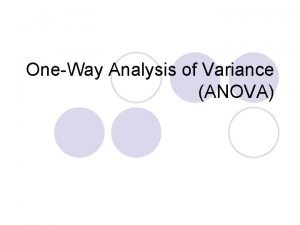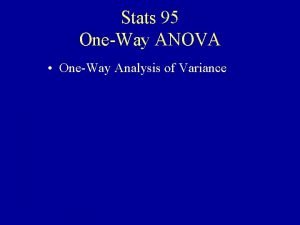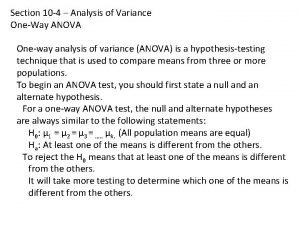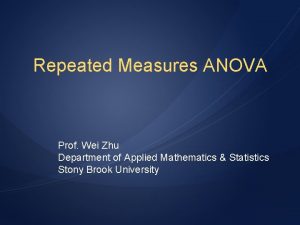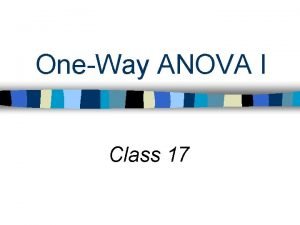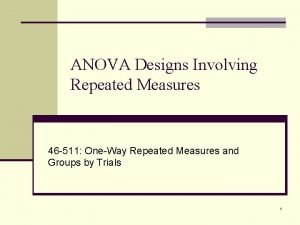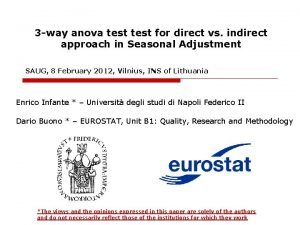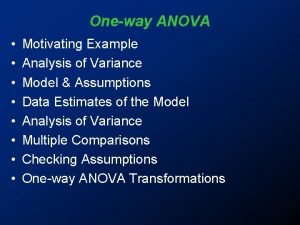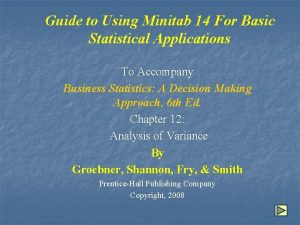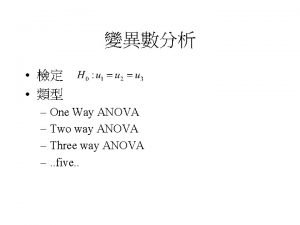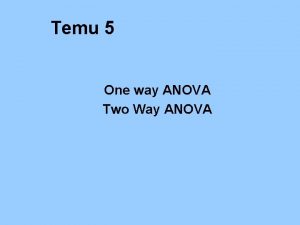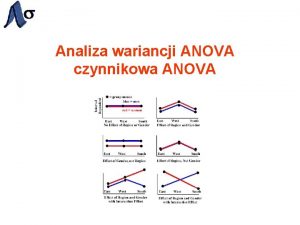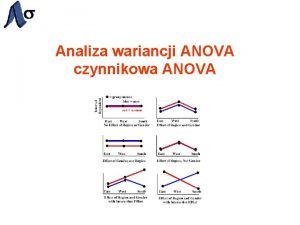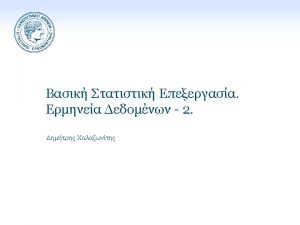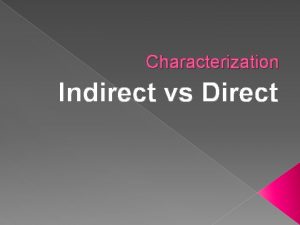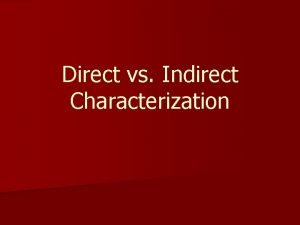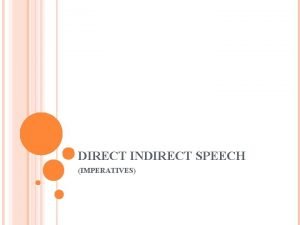3 way anova test for direct vs indirect

















![Buono and Infante test for direct vs. indirect approach in Seasonal Adjustment REFERENCES [1] Buono and Infante test for direct vs. indirect approach in Seasonal Adjustment REFERENCES [1]](https://slidetodoc.com/presentation_image/1ee0740678573158a990a7056fa0d93f/image-18.jpg)

- Slides: 19

3 -way anova test for direct vs. indirect approach in Seasonal Adjustment SAUG, 8 February 2012, Vilnius, INS of Lithuania Enrico Infante * – Università degli studi di Napoli Federico II Dario Buono * – EUROSTAT, Unit B 1: Quality, Research and Methodology *The views and the opinions expressed in this paper are solely of the authors and do not necessarily reflect those of the institutions for which they work

Buono and Infante test for direct vs. indirect approach in Seasonal Adjustment INTRODUCTION A generic time series Yt can be the result of an aggregation of p series: We focus on the case of the additive function: SAUG, 9 February 2012, Vilnius, INS of Lithuania 2

Buono and Infante test for direct vs. indirect approach in Seasonal Adjustment INTRODUCTION To Seasonally Adjust the aggregate, different approaches can be applied Direct Approach The Seasonally Adjusted data are computed directly by Seasonally Adjusting the aggregate Indirect Approach The Seasonally Adjusted data are computed indirectly by Seasonally Adjusting data per each series SAUG, 9 February 2012, Vilnius, INS of Lithuania 3

Buono and Infante test for direct vs. indirect approach in Seasonal Adjustment INTRODUCTION Mixed Approach If it is possible to divide the series into groups, then it is possible to compute the Seasonally Adjusted figures by summing the Seasonally Adjusted data of these groups Group A Group B Example (two groups): SAUG, 9 February 2012, Vilnius, INS of Lithuania 4

Buono and Infante test for direct vs. indirect approach in Seasonal Adjustment THE BASIC IDEA To use the Mixed Approach, sub-aggregates must be defined We would like to find a criterion to divide the series into groups The series of each group must have common regular seasonal patterns How is it possible to decide that two or more series have common seasonal patterns? NEW TEST!!! SAUG, 9 February 2012, Vilnius, INS of Lithuania 5

Buono and Infante test for direct vs. indirect approach in Seasonal Adjustment WHY A NEW TEST? Direct and indirect: there is no consensus on which is the best approach Direct + - • Transparency • Accuracy • No accounting consistency • Cancel-out effect Indirect • Accounting Consistency • Residual Seasonality • Calculations burden SAUG, 9 February 2012, Vilnius, INS of Lithuania It could be interesting to identify which series can be aggregated in groups and decide at which level the SA procedure should be run This test gives information about the approach to follow before SA of the series 6

Buono and Infante test for direct vs. indirect approach in Seasonal Adjustment THE TEST The classic test for moving seasonality is based on a 2 -way ANOVA test, where the two factors are the time frequency (usually months or quarters) and the years. This test is based on a 3 -way ANOVA model, where three factors are the time frequency, the years and the series The variable tested is the final estimation of the unmodified Seasonal. Irregular differences (or ratios) absolute value Additive model Multiplicative model If the series are not modelled with the same decomposition model, then the data must be normalized by the column (the time frequency factor). The series is then considered already Calendar Adjusted SAUG, 9 February 2012, Vilnius, INS of Lithuania 7

Buono and Infante test for direct vs. indirect approach in Seasonal Adjustment THE TEST The model is: Where: • ai, i=1, …, M, represents the numerical contribution due to the effect of the i-th time frequency (usually M=12 or M=4) • bj, j=1, …, N, represents the numerical contribution due to the effect of the j-th year • ck, k=1, …, S, represents the numerical contribution due to the effect of the k-th series of the aggregate • The residual component term eijk (assumed to be normally distributed with zero mean, constant variance and zero covariance) represents the effect on the values of the SI of the whole set of factors not explicitly taken into account in the model SAUG, 9 February 2012, Vilnius, INS of Lithuania 8

Buono and Infante test for direct vs. indirect approach in Seasonal Adjustment THE TEST The test is based on the decomposition of the variance of the observations: Between time frequencies variance Between years variance Between series variance Residual variance SAUG, 9 February 2012, Vilnius, INS of Lithuania 9

Buono and Infante test for direct vs. indirect approach in Seasonal Adjustment THE TEST The table for the ANOVA test VAR Mean Sum of Squares SAUG, 9 February 2012, Vilnius, INS of Lithuania df 10

Buono and Infante test for direct vs. indirect approach in Seasonal Adjustment THE TEST The null hypothesis is made taking into consideration that there is no change in seasonality over the series The test statistic is the ratio of the between series variance and the residual variance, and follows a Fisher-Snedecor distribution with (S-1) and (M-1)(N-1)(S-1) degrees of freedom Rejecting the null hypothesis is to say that the pure Direct Approach should be avoided, and an Indirect or a Mixed one should be considered SAUG, 9 February 2012, Vilnius, INS of Lithuania 11

Buono and Infante test for direct vs. indirect approach in Seasonal Adjustment SHOWING THE PROCEDURE - EXAMPLE The most simple case: the aggregate is formed of two series, using the same decomposition model Do X 1 t and X 2 t have the same seasonal patterns? Rejecting H 0: the two series have different seasonal patterns Indirect Approach Not rejecting H 0: the two series have common regular seasonal patterns Direct Approach TEST SAUG, 9 February 2012, Vilnius, INS of Lithuania 12

Buono and Infante test for direct vs. indirect approach in Seasonal Adjustment NUMERICAL EXAMPLE Let’s consider the Construction Production of the three French speaker European counties: France, Belgium and Luxembourg (data are available on the EUROSTAT database). The time span is from Jan-01 to Dec-10 To take an example, a very simple aggregate could be the following: VAR Mean Square df Months 1. 5003 11 Years 0. 0226 9 Series 0. 1356 2 Residual 0. 0117 198 SAUG, 9 February 2012, Vilnius, INS of Lithuania There is no evidence of common seasonal patterns between the series at 5 per cent level The Direct Approach should be avoided 13

Buono and Infante test for direct vs. indirect approach in Seasonal Adjustment NUMERICAL EXAMPLE If two of them have the same seasonal pattern, a Mixed Approach could be used. So the test is now used for each couple of series LU - FR BE - FR VAR Mean Square df Months 2. 0403 11 Months 1. 0464 11 Years 0. 0140 9 Years 0. 0172 9 Series 0. 1199 1 Series 0. 0793 1 Residual 0. 0016 99 Residual 0. 0164 99 There is no evidence of common seasonal patterns between the series at 5 per cent level SAUG, 9 February 2012, Vilnius, INS of Lithuania There is no evidence of common seasonal patterns between the series at 5 per cent level 14

Buono and Infante test for direct vs. indirect approach in Seasonal Adjustment NUMERICAL EXAMPLE LU - BE VAR Mean Square df Months 0. 9579 11 Years 0. 0202 9 Series 0. 0042 1 Residual 0. 0181 99 Common seasonal patterns between the series present at 5 per cent level LU and BE have the same seasonal pattern, so it is possible to Seasonally Adjust them together, using a Mixed Approach An excel file with all the calculations is available on request SAUG, 9 February 2012, Vilnius, INS of Lithuania 15

Buono and Infante test for direct vs. indirect approach in Seasonal Adjustment FUTURE RESEARCH LINE Starting from this idea, there is still work to do!!! Create theoretical base Testing with real data Presentation at CFE'11 & ERCIM'11, 17 -19 December 2011, University of London, UK Implementation in R SAUG, 9 February 2012, Vilnius, INS of Lithuania 16

Buono and Infante test for direct vs. indirect approach in Seasonal Adjustment FUTURE RESEARCH LINE Starting from this idea, there is still work to do!!! Theoretical review (co-movements test) Case study (IPC using Demetra+) Simulations (R) Application with a Tukey’s range test SAUG, 9 February 2012, Vilnius, INS of Lithuania 17
![Buono and Infante test for direct vs indirect approach in Seasonal Adjustment REFERENCES 1 Buono and Infante test for direct vs. indirect approach in Seasonal Adjustment REFERENCES [1]](https://slidetodoc.com/presentation_image/1ee0740678573158a990a7056fa0d93f/image-18.jpg)
Buono and Infante test for direct vs. indirect approach in Seasonal Adjustment REFERENCES [1] J. Higginson – An F Test for the Presence of Moving Seasonality When Using Census Method II-X-11 Variant – Statistics Canada, 1975 [2] R. Astolfi, D. Ladiray, G. L. Mazzi – Seasonal Adjustment of European Aggregates: Direct versus Indirect Approach – European Communities, 2001 [3] F. Busetti, A. Harvey – Seasonality Tests – Journal of Business and Economic Statistics, Vol. 21, No. 3, pp. 420 -436, Jul. 2003 [4] B. C. Surtradhar, E. B. Dagum – Bartlett-type modified test for moving seasonality with applications – The Statistician, Vol. 47, Part 1, 1998 [5] R. Astolfi, D. Ladiray, G. L. Mazzi – Business cycle extraction of Euro-zone GDP: direct versus indirect approach – European Communities, 2001 [7] J. Lothian, M. Morry - A set of Quality Control Statistics for the X-11 -ARIMA Seasonal Adjustment Method – Statistics Canada, 1978 [8] R. Cristadoro, R. Sabbatini - The Seasonal Adjustment of the Harmonised Index of Consumer Prices for the Euro Area: a Comparison of Direct and Indirect Method – Banca d’Italia, 2000 [9] B. Cohen – Explaning Psychological Statistics (3 rd ed. ), Chapter 22: Three-way ANOVA - New York: John Wiley & Sons, 2007 [10]I. Hindrayanto - Seasonal adjustment: direct, indirect or multivariate method? – Aenorm, No. 43, 2004 SAUG, 9 February 2012, Vilnius, INS of Lithuania 18

Buono and Infante test for direct vs. indirect approach in Seasonal Adjustment QUESTIONS? Many Thanks!!! SAUG, 9 February 2012, Vilnius, INS of Lithuania 19
 Perbedaan one way dan two way anova
Perbedaan one way dan two way anova One way anova vs two way anova
One way anova vs two way anova Contoh soal uji two way anova
Contoh soal uji two way anova Two way anova
Two way anova 2 way anova example
2 way anova example Anova
Anova Minitab equivalence test
Minitab equivalence test Two-way anova r
Two-way anova r F testi formülü
F testi formülü One way anova table
One way anova table One way anova null hypothesis
One way anova null hypothesis One way anova
One way anova Repeated measures anova f value
Repeated measures anova f value One way anova table
One way anova table Two-way repeated measure anova
Two-way repeated measure anova Direct vs indirect approach
Direct vs indirect approach Four way anova
Four way anova Three way anova in excel
Three way anova in excel One way anova jmp
One way anova jmp Two way anova minitab 17
Two way anova minitab 17





